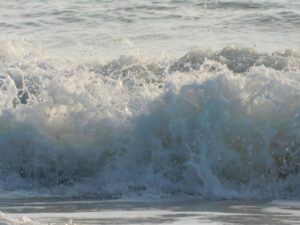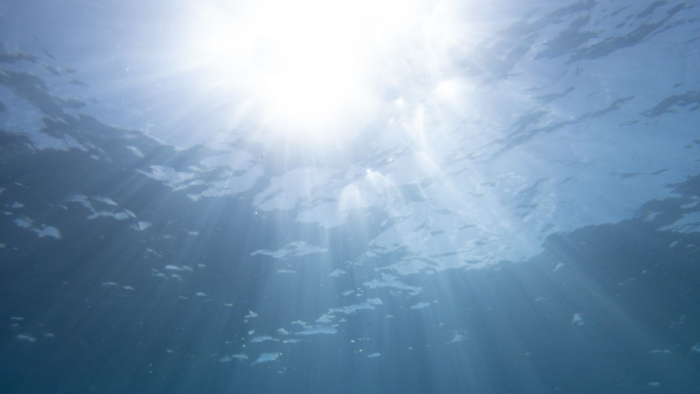By: Alli Cutting and Michaela Stenerson, A Rocha USA Marine Conservation Interns
The MindLife today is filled with information and stimulation, vying for our attention—screens, images, emails, texts, traffic, and crowds. Our brains do a lot of processing to make meaning from all that comes our way.
Scientists today are seeking to understand what happens cognitively and emotionally when we are near water. This new field of study is led by marine biologist turned neuroscientist, Dr. Wallace J. Nichols, and the key finding is that our brains enter a mildly meditative state when exposed to water. Nichols calls this state “Blue Mind.”
“Red Mind” is the term Nichols gives to the mental state accompanied by the stress hormones of cortisol and adrenaline. Red Mind occurs as a fight or flight mode in survival situations, helps us assess risk, meet deadlines, win games, and make decisions. It is a good and necessary function in life! Yet a prolonged state of Red Mind can put us in a constant state of anxiety. In our modern society, this is common. Keep this up for too long, and we can go into “Grey Mind”, which Nichols calls “the ashes from the red mind fire”. Here, lethargy, burnout, and depression take hold.
We have both personally experienced Red and Grey Mind and how these states can negatively affect all aspects of life; including relationships, school, work, and physical health. We know many others have experienced this, particularly with the stress of the COVID-19 pandemic. Now more than ever, there seems to be space to talk openly about such struggles. Yet even still, there can be stigmas and a separation between treating physical and mental well-being. The reality is they are interconnected — our environment, body, and brain affect one another. Water and the various effects it can have on our health and well-being is one such example of this interconnectedness.

The Mind and Water
Blue Mind is the state of calm, connectedness, and clarity that occurs when we are near, in, on, or under water.
Water is a part of us. We all began life in a watery womb. Our bodies and brains contain 60% and 75% water respectively. Our blood and amniotic fluid hold the same salt concentration as seawater. Humans can only survive seven days without water.
Water draws us in. We spend our vacations lounging on the beach and playing along the river bank. We swim, dive, fish, sail, kayak, and surf to recreate. We take a shower or bath to cleanse and relax. We more highly value land with water views and access. There is clearly an innate connection between us and water.
The Science
Nichols’ research demonstrates the impact of water exposure on our brain, which is a result of environmental, physiological, and chemical factors.
Environmental –
Bodies of water create a simplified environment. Auditory, water drowns out other noises and creates a consistent soundscape. Visually, a big swath of blue creates a consistent background. These constants give our brain a break from processing information. It enables involuntary attention, where we can more easily notice anything surprising or novel that breaks the consistent environment. The environment is predictable, but not mundane – we are soothed, yet aware. This aids us in survival, by quickly spotting the threat of a creature wanting to eat us, as well as by enabling creative problem-solving in other areas of our life.
Physiological –
Being in water triggers the dive reflex, a physiological response found in all mammals to keep us from drowning by slowing everything in our bodies down. When our face hits the water, our heart rate slows, our blood vessels restrict, our skin cools, and oxygen is preserved for our vital organs. The parasympathetic nervous system kicks in to calm and relax us. This is in opposition to the sympathetic nervous system, which drives the fight or flight response.
Chemical –
The sight and sound of water trigger a response in the brain, letting us know we are in the right place. It does this through hormones, with an increased release of dopamine (i.e., the feel-good hormone), serotonin (i.e., the happiness hormone), and oxytocin (i.e., the cuddle hormone). It also decreases cortisol levels, essentially drawing away stress and replacing it with relaxation.

Water and Healing
Water lets us flip the switch to change from Red and Grey mind to Blue Mind. This switch triggers changes in our brain and body, which allow us to calm down enough to connect with clarity and creativity.
Water is a healer. Swimming is used in occupational therapy with stroke patients, kayaking is used in post-traumatic stress therapy with veterans and cold plunge is used to reduce inflammation in athletes. It is well-accepted that what we put in our body (food) and how we move our body (exercise) affects both our physical and mental health. Science is now understanding how we surround our body, and the environment in which we put it, also has a dramatic impact.
We have felt the healing effects of water in our experiences with mental health. When immersed in a sea of greens and blues, our senses engage. We notice small details, such as crabs crawling, light reflecting, and birds darting. We taste the salt, smell the mangroves, scan the horizon, and feel the direction of the wind on our wet faces. We are pulled out of our heads, out of nervousness and overthinking, and into our bodies. Our perspectives shift. We are connected to ourselves, to each other, to the world around us, and the Creator. We are put in awe and wonder of life and reminded of our lack of control, our need to surrender, and His ultimate grace. Water wakes us up.
As marine conservation interns in Titusville, Florida, the water nearby is the Atlantic Ocean and the Indian River Lagoon. What is your water? It can be man-made or natural, as big as the ocean or as small as the bathtub – the sight and sound alone trigger the same response. What is important is getting into it, prioritizing it, and fostering that connection between yourself and water. We encourage you to find your water, to enjoy it, to consider how it takes care of you (e.g., cognitively, emotionally, psychologically, physically, socially, spiritually), and in turn to ask how you might better take care of it. Water is a gift that offers healing, and in turn, we can then work towards healing relationships with ourselves, each other, our planet, and God.
Resources
Blue Mind: The Surprising Science That Shows How Being Near, in, on, or Under Water Can Make You Happier, Healthier, More Connected and Better at What You Do – written by Wallace J. Nichols.
TEDx Talks – “Your Brain on Nature”
Microsoft Research – “Blue Mind: The Surprising Science That Shows How Being Near, In, On, or Under Water Can Make You Happier, Healthier, More Connected, and Better at What You Do”
CBS Mornings – “Blue Mind: Mental health benefits of being near water”
TEDx Talks – “Blue Mind in the Desert”
“Blue Mind: Water Is Medicine”
The fifth installment of A Rocha’s Elements of Hope video series, titled Blue, delves into the relationship between mental health challenges and the positive effects of nature on our wellbeing. Learn more about how nature can improve our mental health with our study guide. Feel free to share the study guide and film with your church, school, bible study or youth group.








Add a Comment